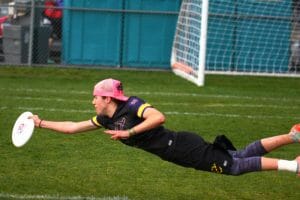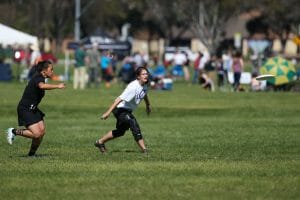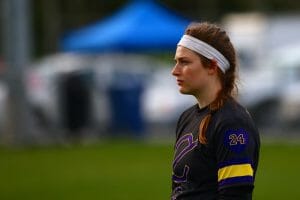Washington Element's roster has changed dramatically since last season, in large part due to the addition of seven graduate student transfers. Yet they'll be one of the most unified - and dangerous - teams at Nationals.
May 21, 2015 by Keith Raynor in Profile with 0 comments

Do you remember that first practice with an established team? Looking around as you approach the fields, trying not to get caught as your gaze greedily takes in any and all information, whether you mean to or not. You see people in team gear from seasons past, more tangible but less resonant proof than the nicknames and inside jokes careening around even faster than the disc the returners are tossing. As you tie your cleats, you feel the butterflies in your gut, creeping in a way that makes you think they might be caterpillars instead.
You want to look like you know what you’re doing – project some level of athleticism – in warmups. It’d be nice to look at least coordinated during the first drill, parsing through the team’s local jargon in a rapid translation process. Looking dumb is not an option.
Do you remember months later? Practices, meals, car rides together. Sprints, drills, team meetings together. Parties, inside jokes, stories together. Do you remember being a part of team, and looking back on being a prospective member of the group, smile and wonder how it all happened?
Every year, players all over the country make their way through this experience. Maybe not the exact one – I mean, the caterpillars thing might be just me – but something like it. But the number of players who do it with Nationals on the line is much smaller. The number that have a lengthy legacy to live up to is far fewer.
It might be easier if you and your cohort joining that team all knew how to throw a flick. Or if you had played college ultimate before. Or even club ultimate. Or even gone to college nationals. Or club nationals. Or won club nationals. Or played at Worlds. That might help release the butterflies and free the caterpillars.
The graduate students of Washington Element have come from varied backgrounds, cities, and teams. In Seattle, they found a team ready and waiting for their talent, energy, and leadership. It has all coalesced into one of the best college ultimate teams in the women’s division.
*****
By the time I saw Washington Element play at Northwest Challenge, they were the majority of the way through their season. I had seen them play previously at the Stanford Invite and on film from some unsanctioned scrimmages. But one thing was very clear at their home tournament in Seattle: they were one unified team.

Discerning which seven made up the cohort of rookie grads would have proved challenging. Surely, it wasn’t the tall handler adorned with the knee brace, checking the disc in on defensive possessions. Or the speedster in the colorful hats and headbands racking up goals and run through Ds. Or the lengthy defender apt to crack jokes on the sideline with her coach or roar with fierceness from the sidelines in the name of her teammates. It couldn’t be the crafty handler soaking up touches and launching hucks with guile.
But it was. It was Andrea Wilson and her knee brace, Tess Young and her hat, Eugenia Prezdho and her intensity, Emma Kahle and her veteran presence. While each carried unique traits, they cheered, strategized, and triumphed as if they had been Elements from freshman fall.
Their talent was obvious but it was their fledgling harmony with one another and their more tenured teammates that begat success. Nora Landri knew when to streak deep for a bomb from Kahle. Captain Cami Canter knew when Young was winning her matchup in the red zone. Co-captain Vickie Su could sense when Kristen Poinar needed a little extra push. In fact, of the assemblage of players, only star 4th year Sarah Edwards looked out of sorts, seams visible in her game after months off that had concluded that morning.
To understand what becoming a singular entity means for Element, you’ll have the consider the many individuals that were willing to sacrifice some portion of themselves for the good of the greater whole. For the seven graduate students joining Element, that meant deciphering which parts of their past to let go and which ones to absorb.
Among their cohort, Andrea Wilson alone had been at a college tournament of the Northwest Challenge’s caliber. In fact, her former team, Colorado Kali, had traveled there the year prior. For her, the similarities were strong and adjustment minimal. The environment of the team was less a stranger and more an acquaintance.
Tess Young and Liz Conway were well acquainted to Washington, too. Young was a former captain at Utah, another Northwest Region team, and Conway had come from Salt Lake City with her teammate and roommate. That thin relationship to their new squad, however, didn’t provide them much comfort.
“This year was the first time I attended an Invite tournament of any sort,” Young revealed to me. “I was intimidated by trying out for UW and did not really know what to expect.”
Emma Kahle and Lauren Sadler had the big game experience, but came from smaller teams from across the continent. Kahle starred for Columbia, where she won Metro East Player of the Year in 2014, and spent a season with BENT. Sadler’s American University team had to battle just to make AC regionals, but she had already conquered two club nationals with Scandal. The two Seattle natives had something to come home to and knew what it took to compete at the highest levels.
Like Kahle and Sadler, Eugenia Prezdho came from the east coast, but without the fancy ultimate resume. Prezdho was a central player for Rochester, a Metro East regional up and comer that battled with Kahle’s Columbia squad at Regionals in 2014.
And the odd woman out – at least in terms of ultimate history – was Kristen Poinar. The 30 year old grad student had never played college ultimate. Five years prior, she began playing in Seattle leagues and soon was embedded in the community. Now, she’ll be the oldest player at the College Championships, in just her first high stakes ultimate.
It could have been a disaster. They were joining a team going through its own growth. The returners for Washington had let their previous core1 do so much of the talking and tell so much of their story, but now they were searching for their own voices. Suddenly, the team was injected with novel accents from players from other cultures, and needed to incorporate their speech into their fresh narrative.
The challenges they faced helped squeeze their many cadences into one voice. A Friday night loss at the hands of rival Oregon in front of a packed crowd was frustrating. Close games against Victoria and Dartmouth followed. Gritty battles with Virginia and Stanford came after. In all cases (save Oregon), Element found a way to win. Without room for error, it just forced them all to stand closer to one another as the walls closed in.
Despite disparate backgrounds, a team that lost six of its top seven from the year prior, was at the year’s toughest tournament and kicking butt.
*****
Before those games in March – before Washington secured their division-leading 8th straight nationals berth – was months of figuring it out.
“Adjusting to the pace of learning was difficult,” explained Conway, perhaps the least experienced of the group. “Some days I felt like I was having more new and difficult concepts thrown at me in practice than in class, and I’m in medical school.”

Aside from Wilson, dealing with the demands of an elite college team was an adjustment none of the seven had faced before. The strategies were more advanced, the details more pronounced, the terminology more deliberate. The fitness expectations were raised, from a physical standpoint, but also from a mental standpoint. The hours and commitment level pushed them to their boundaries. Making it all work with not only each other, but within the confines of their graduate schedules, in what was, for many of them, a new city.
“I was legitimately nervous coming to Washington this fall and trying out,” said Young. “I imagined a tight knit group with tons of playing experience and that I would be coming in as an outsider, and only have the ability to play a single year.”
Stepping into the relationships that define the college ultimate experience was even more daunting than the expectations.
“It helped a lot early on to know there were other people going through the same sort of adjustments as myself — coming from smaller, less competitive programs…” Kahle told me. The other grad student echoed those sentiments.
“Having the other grad students is amazing. I never really felt totally like the ‘new kid’ because there were so many of us in the same boat,” said Sadler. “It’s kind of like a mini community within the full team which was very important in the fall (before breaking into A and B teams) and early in the season when all the returners already knew each other.”
Most teams already have little clusters within the team, often striated by their graduating class. Social subgroups naturally form from friendships and shared experiences, such as a mutual major, membership in another organization, or a mutual club team. Right away, borne of survival instinct and natural gravitation, the grad students found each other a comfort in the foreign territory.
“But all my fears melted away once I met the returning players and all the grad students in the same boat as me,” remembered Young. “These girls are my safety net.”
*****
Sometimes when we talk about teams graduating players, we talk about them “losing” players. We talk about them “moving backwards” and the dreaded r-word. Washington Coach Kyle Weisbrod believes firmly in intentional language. The negative language surrounding this process is a function of the challenges – the fears – it creates and the pain it reminds us of.
The constant of change, the fleeting nature of each college team’s composition, is what makes it beautiful. The finite time players have together makes that time that much more vital, valued, and urgent. It also springs forth ebbs and flows to the college division. Look at it like a good D-line: turnover creates opportunities.
Suddenly, Washington had a new blank slate on which to imprint their newfound personality.
“I think when you’ve spent your entire career playing for a team like UW where nationals feels like a given, it becomes easy to take for granted the opportunity to practice hard in a structured environment,” said Weisbrod, who also stated he thought the team was having the most consistently strong practices of any team he’s coached. “They know that from years of first hand experience where they’ve struggled to get 14 out at practice, had no coach, or never got invited to the best tournaments. Valuing practice in that way and having that sense of urgency has filtered through the whole team.”
The veteran presence and maturity of the grad students is valuable and you could get lost talking about their intangibles, but to recognize that they bring fresh perspectives and spark a hunger in their teams is to make that understandable and digestible. Element’s new injections were a double shot in the arm. And it was more than just their energy.
“Having all of these new, skilled players gives a lot of free parameters, and we’ve been playing with all of those possibilities!” exclaimed Poinar. She added that the process has been surprisingly nonlinear. Weisbrod elaborated.
“The timing of all of these grad students arriving while our returners stepped in to their own meant that they all have been able to author their season,” he said. “They’ve been able to create a culture that they all designed and built.”
To do that, they had to find even ground. Washington embraced the blank slate mentality, the chance to tell their own story in their own words. That meant getting to know one another’s voices and letting each member lend theirs to the process. Element adapted by becoming more collaborative, an intelligent way to not only utilize their imported resources, but also include them.
“We had team meetings at the beginning of the year and throughout the season where we defined ourselves as a team and decided what we wanted for the season,” explained Kahle. “It’s easy to buy in when everyone has input and gets to help make the team what they want it to be.”
Washington’s leadership was cognizant of the fact that the development of a united mentality comes from more than meetings, discussions, and compromises. The best teams enjoy each other, care about each other, and value one another. That takes something a little less structured and a bit more entertaining.
“The team this year that they made a real effort to incorporate us into the team and promote team bonding,” said Wilson, the Colorado Kali transfer. “We had a team retreat in January where the returners planned a bunch of fun things for us ‘rookies’.”

The end result? A cohesive and unified team that plays – and perhaps more importantly, practices and prepares – as if they’ve been together for years. In the recap of the Northwest Challenge, we noted of Element that “There’s a selflessness and unit to their style of play, speaking to a heavy buy in from the team.” While Weisbrod prefers his team avoid external hype, there has to be a swelling of pride at knowing, in a short time, you’ve built a chemistry powerful enough to be seen from outside the walls of your huddle.
“We compared our old programs to how UW did certain things as the season began. But pretty soon we all just felt like one family and the way UW did things became the way we all did them,” sums up Kahle. The way UW has done things has proven quite successful over the years.
*****
The University of Washington has a rich ultimate history. Over the past six seasons – essentially the modern ultimate era – they have established themselves as one of the most powerful programs in the college game. Beginning with a debut appearance in 2001, Element has qualified for the College Championships 10 of 15 seasons. That includes an active streak of eight consecutive appearances, tied for longest in the division with rival Oregon Fugue.
That legacy of success is more than just invites to the dance, but starring roles. They team’s finest effort proved the best in the land in 2012, when they won the National Championship. They’ve reached three finals and five semifinals, and aside from their last place in 2001, have never finished lower than 9th.
A legendary list of players have contributed to the program’s sustained success. Callahan winners Shannon O’Malley and Miranda Roth2 both have suited up in Element gear. Lindsey Wilson, Claire Suver, and more recently, Shira Stern are some of the other well known and highly respected names from the Element family.
As they prepare to take the field in Milwaukee, Washington is bonding tighter and tighter. They’ll rely on those bonds to help them playing the grinding, high energy, yet still system based style of play they use to dictate opponents. While their Regionals performance shoved them down to the 11th seed, the Seattlites will still be one of the favorites to be make the quarterfinals once again, and potentially go beyond that. Their trust will be put to the test.
It likely won’t matter which players have been to nationals before, which players played for what club teams, what their last team did, or how many years they’ve played. “Over the course of the season I think we’ve all come to really respect one another for what everyone can bring to the table, as usually happens on a close-knit team,” said Kahle, “and that enables us to help bring out the best in each one of us!”
Many of the graduate students may not have known Element history. They may not have given much thought to the team’s legacy. But now, they’ll travel to Milwaukee with a chance to follow the path they’ve forged and add their own contributions to the Element annals. They’ll do it in their own myriad scripts, styles, and languages. They’ll do it together as Washington Element.